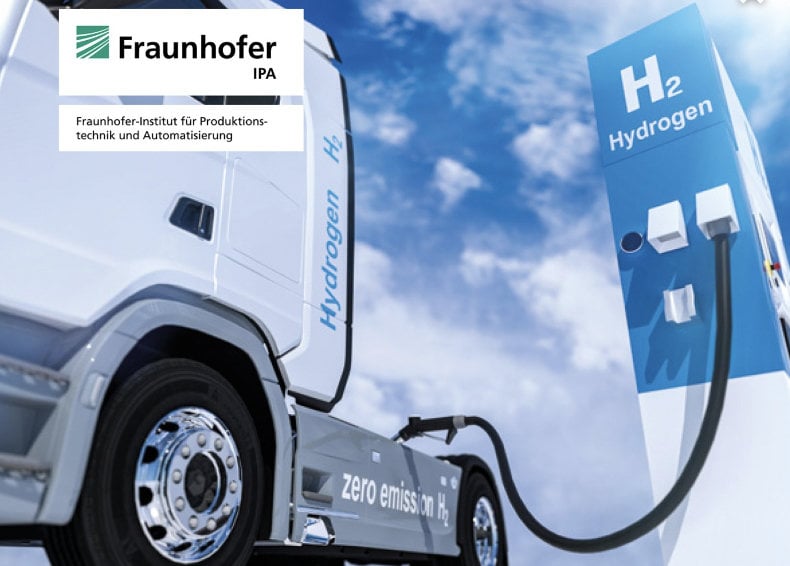www.magazine-industry-usa.com
01
'22
Written on Modified on
GREEN HYDROGEN FROM PLANT RESIDUE
Until now, the most common way to dispose of green waste and sewage sludge has been to compost or incinerate it. However, using these materials to produce the valuable energy source hydrogen would make far more sense. A team of researchers at the Fraunhofer Institute for Manufacturing Engineering and Automation IPA is working towards this very goal.

There is no shortage of organic waste in Germany. According to the German Environment Agency, approximately 4.6 million tons of it ended up in the compost bins of German households last year alone. This doesn’t include waste from public parks and gardens, agriculture and food production, as well as sewage sludge and leftovers from canteens – all in all, it comes to a good 15 million tons. Most of it is brought to composting plants, or is incinerated to generate heat and electricity. This creates carbon dioxide (CO2) emissions, which harm our climate. “Organic waste is far too valuable to be used in this way,” says Johannes Full, head of the Sustainable Development of Biointelligent Technologies group at Fraunhofer IPA in Stuttgart. “It would make more sense to use the material to generate hydrogen. The CO2 emitted during the process could then be separated, stored or used in industrial applications.” Many people consider hydrogen to be the clean energy carrier of the future. During its utilization in energy conversion processes only water is released. But as it stands, hydrogen is still largely produced from natural gas. A production process based on plant residue would be much more climate friendly, in much the same way as electrolysis with renewable electricity.
Reducing the level of CO2 in the atmosphere
The past few years have seen the development of a wide variety of processes for converting biomass into hydrogen. In their analysis, Full and his colleagues evaluated which of these processes are technologically mature and could be operated efficiently in the future. The new conversion methods are also expected to be an answer to a certain weakness in conventional organic waste management: Regardless of whether biomass is composted or burned, it always releases carbon dioxide that the plants absorbed from the air beforehand via photosynthesis. It would make more sense to capture this greenhouse gas from the plants with the intention to either use it as a raw material in the chemical industry or store it underground in abandoned natural gas fields. “That way, we kill two birds with one stone,” says Full. “We contribute to reducing the amount of carbon dioxide in the atmosphere, while also using plant residue to produce green hydrogen in the process.”
Using biomass to its full potential
A project that Fraunhofer IPA is conducting with a company in the metal industry demonstrates the potentials in biomass. In this project, waste from local fruit farmers and vintners, as well as cardboard, wood and canteen waste can be converted into hydrogen. This hydrogen is then directly put to use in metal processing. The first step of the process is fermenting the leftover fruit and canteen waste with the help of bacteria in dark containers to produce hydrogen and carbon dioxide. The fermented mass can then be converted to methane through another fermentation process at a conventional biogas plant. The methane in turn is converted to hydrogen and CO2. By contrast, wood and paper fibers are difficult to ferment in this way. They can be split into CO2 and hydrogen using a wood gasifier. As part of this project, Fraunhofer IPA is comparing the different process options to help choose the most suitable and efficient technologies. Furthermore, IPA researchers are developing technical optimization approaches to reduce costs and ensure that the respective processes are as environmentally friendly as possible.
Producing hydrogen from purple bacteria
Purple bacteria are particularly efficient at producing hydrogen from fruit and dairy waste. Researchers at the University of Stuttgart have succeeded in modifying the bacterium in such a way that it hardly requires light, meaning that the hydrogen production process requires less energy. Together with Fraunhofer IPA, they are investigating financially viable methods of producing hydrogen with purple bacteria on a larger scale in the future. As part of the H2Wood – BlackForest project, the team at Fraunhofer IPA is also collaborating with the Fraunhofer Institute for Interfacial Engineering and Biotechnology IGB to explore how microbes can break down wood waste to form hydrogen and other valuable molecules for the chemical industry. Other project partners include Campus Schwarzwald and the Institute of Industrial Manufacturing and Management IFF at the University of Stuttgart.
Industrial Hydrogen Hubs in Baden-Württemberg study
The study entitled “Industrial Hydrogen Hubs in Baden-Württemberg” (“I-H2-Hub-BW” for short) conducted by Fraunhofer IPA demonstrates that green hydrogen has the potential to cover certain energy demands of selected industrial sectors and heavy goods traffic regionally. The researchers found that decentralized hydrogen production and use pay off if the distribution centers (i.e., hubs) are strategically positioned. Using green electricity, these hubs operate electrolyzers, which split water into hydrogen and oxygen. In order to avoid transport costs, the hubs must be as close as possible to consumers.
The second important criterion for the choice of location is therefore the local industry’s need for process heat, high-temperature processes and hydrogen gas, for example for the production of nitrogen fertilizer. Infrastructure is equally important: “Ideal locations are near busy roads with truck depots where hydrogen filling stations can be set up,” says Dr. Jürgen Henke, scientist at Fraunhofer IPA. With the help of the location criteria, the research team led by Henke identified possible locations in Baden-Württemberg – above all the Rhine-Neckar metropolitan region and the greater Karlsruhe area. With the help of computer simulations, researchers at Fraunhofer IPA demonstrated that in specific scenarios 30 percent of fossil energy could be replaced within ten years by regionally produced green hydrogen – using only the state’s own open spaces.
www.fraunhofer.de

